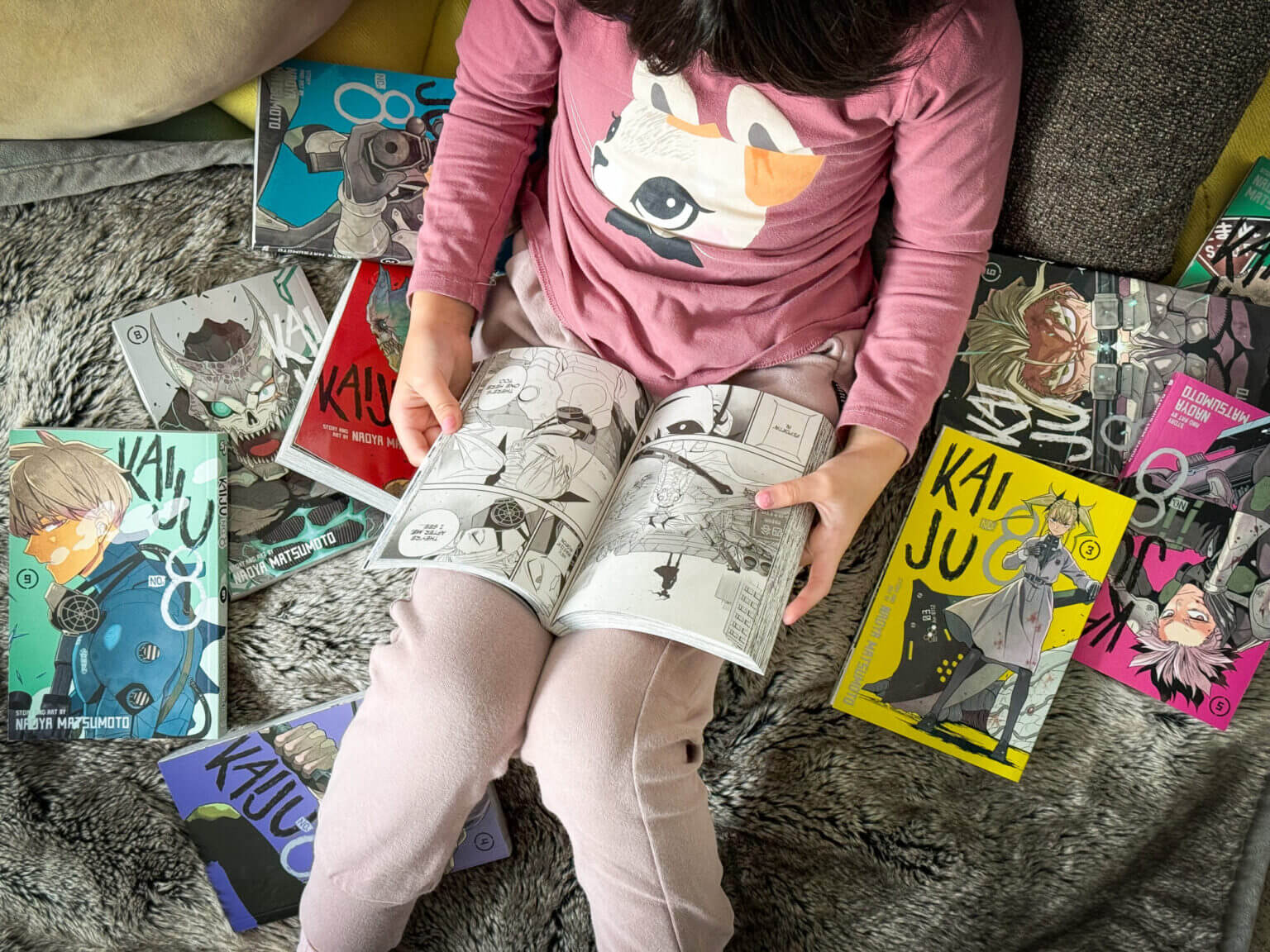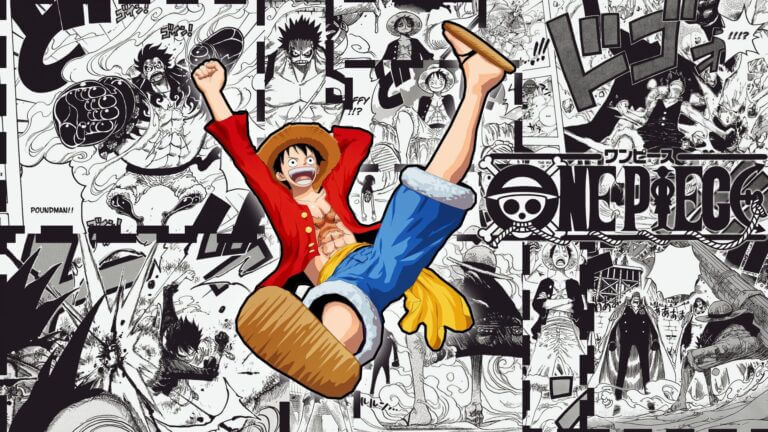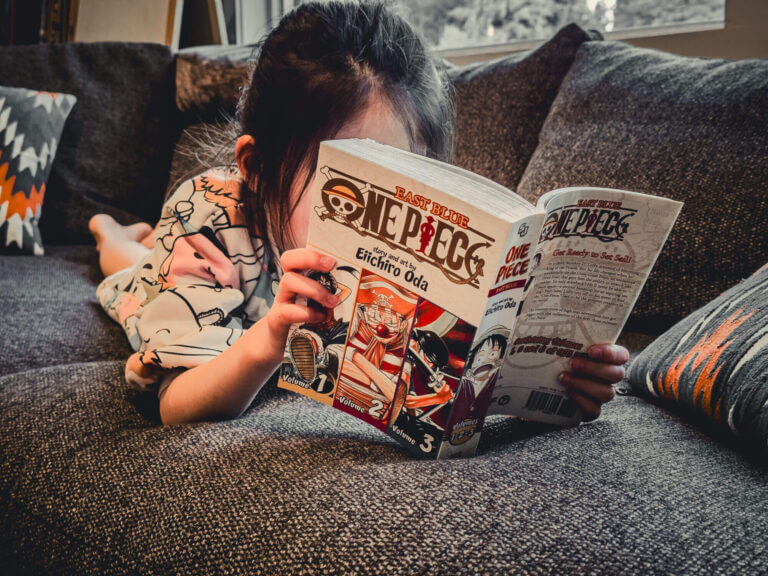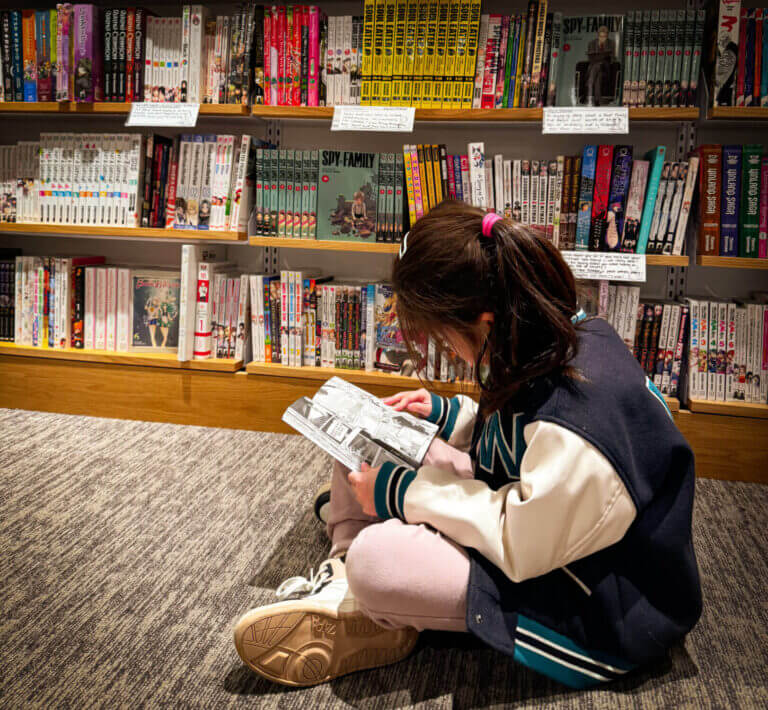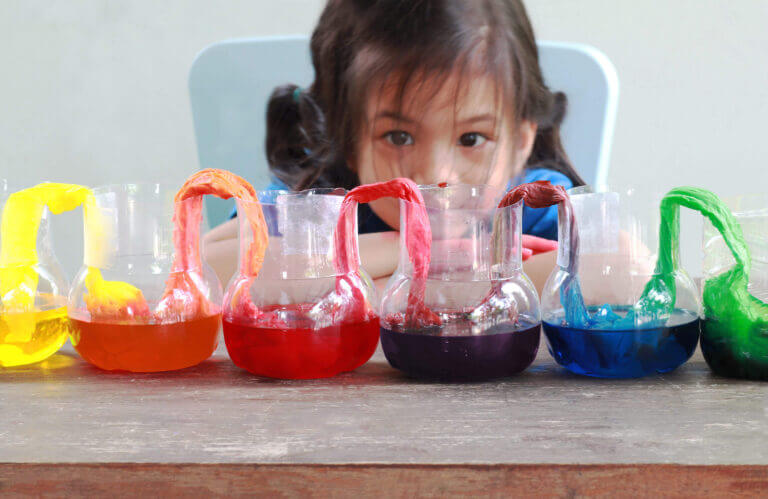Looking for a manga that’s full of action, laugh-out-loud humor, and strong role models? Kaiju No. 8 might be just what your young reader needs. In this Kaiju No. 8 parents guide, we’ll walk you through the storyline, age-appropriateness, and what makes this series such a hit with kids.
Table of Contents
Is Kaiju No. 8 Suitable for Kids?
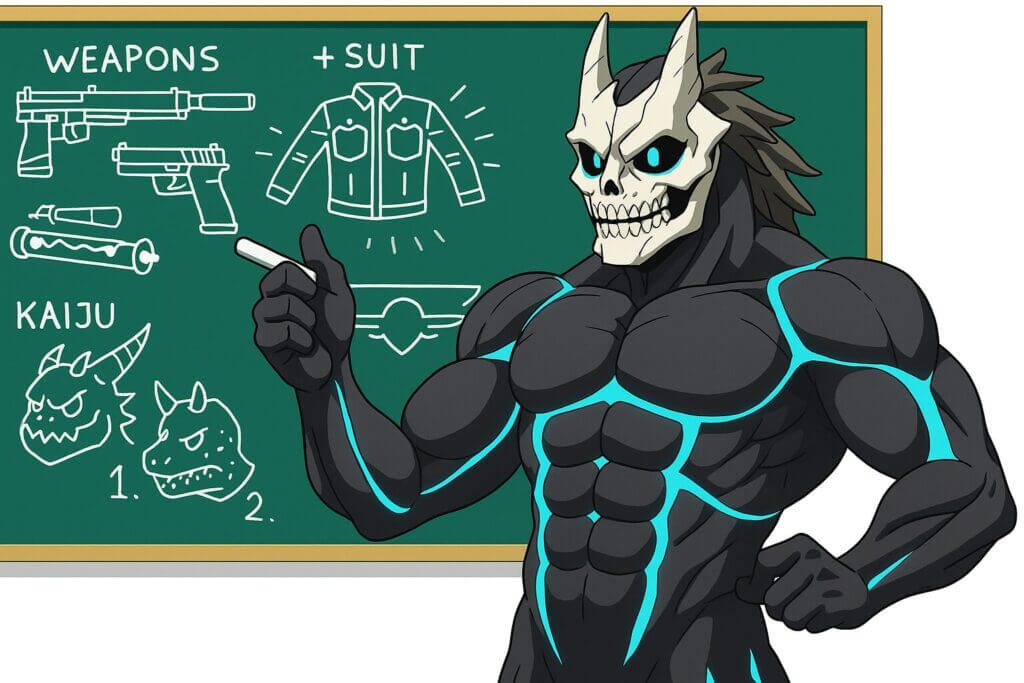
Age Recommendation: 10+
We recommend the series for kids around age 10 and up to fully appreciate the emotional layers and story development. That said, younger readers can still enjoy it! Our seven-year-old loves watching Kafka take on Kaiju, discover new powers, build amazing friendships, and, of course, giggle at all the silly and surprising moments. It’s more than just a monster-fighting manga—it’s a fun, inspiring journey that keeps kids (and parents) hooked.
- Title: Kaiju No. 8
- Story and Art: Naoya Matsumoto
- Year Started: December 2021
- Age Recommendation: 10+
- Genre: Shonen, Action, Sci-Fi, Adventure
*Our age ratings are based on our opinions and our daughter’s preferences, who reads above her age level. They’re meant as general guidance, but may vary and aren’t official standards.
Why Kaiju No. 8 is a Great Manga for Kids
Beyond the excitement and humor, Kaiju No. 8 dives into meaningful themes like courage, friendship, and the beauty of second chances. Kafka Hibino, the main character, is especially relatable—he once gave up on his dream of joining the Defense Force, but life had other plans. His transformation into a Kaiju and determination to try again shows kids that it’s never too late to chase your goals. It’s an empowering message wrapped in thrilling action and laugh-out-loud moments.
Content Considerations for Parents
If you’re wondering Is Kaiju No. 8 appropriate for kids?, this section breaks down what parents should know before handing it off to younger readers. While this action-packed series has a lot to love—like humor, friendship, and great role models—it’s still helpful to understand the content that comes with the genre.
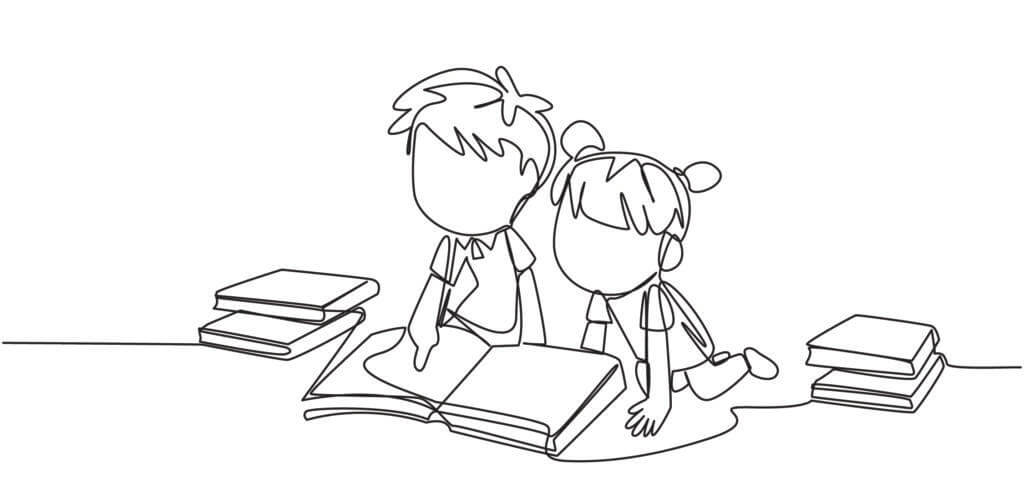
Violence and Action
As you’d expect from a monster-fighting manga, Kaiju No. 8 contains frequent battle scenes between the Defense Force and giant Kaiju. There’s explosive action, dramatic injuries, and some intense imagery—like severed limbs or Kaiju bodies being blown apart. However, it’s not overly graphic or gory by manga standards. The illustrations focus more on the energy and movement of battle than realistic blood and trauma. If your child is okay with other shonen series like My Hero Academia or Naruto, this is right in that same ballpark.
Nudity or Suggestive Content
Nudity in Kaiju No. 8 is minimal and handled in a tame, non-sexual way. There’s one notable scene where Captain Mina Ashiro is shown sitting in a bathtub after a long day of battle. The moment highlights her strength and battle scars more than anything else—it’s a quiet, reflective panel with no explicit detail or focus on nudity. In fact, my elementary-aged daughter read right past it without even noticing.
There are also a few humorous instances where Kafka ends up without clothes after transforming back from his Kaiju form. These scenes rely on classic anime-style slapstick—think convenient clouds or objects blocking anything inappropriate. It’s more funny than edgy and very similar to what you’d find in other kid-friendly manga or anime.
If your child is already reading shonen manga like My Hero Academia or One Piece, Kaiju No. 8 should feel perfectly appropriate in this regard.
Swearing and Language
There is some light swearing sprinkled throughout the dialogue, especially in moments of stress or comedy. Words like “hell,” “damn,” or occasional stronger phrases may appear depending on the English translation. It’s not constant or aggressive, but it’s worth noting for families who are sensitive to language.
Final thoughts for parents
The Kaiju No. 8 age rating is generally recommended for ages 12 and up, but some mature 10-year-olds—especially those familiar with action-oriented manga—may enjoy it with a little parental guidance. As a whole, Kaiju No. 8 balances its darker moments with humor, hope, and heartfelt storytelling. This Kaiju No. 8 parents guide gives it a green light for older elementary or middle school readers who enjoy adventure, fantasy, and a dose of silliness with their hero’s journey.
Kaiju No. 8 Plot: What’s the Story About?
The Kaiju No. 8 plot centers around Kafka Hibino, a regular guy turned monster-fighting hero, as he battles massive Kaiju while hiding a pretty big secret—he’s part Kaiju himself! The mix of thrilling fight scenes and goofy, exaggerated comedy makes it a blast to read. My daughter couldn’t stop laughing at the slapstick humor, and she especially loved seeing fierce female characters like Captain Mina Ashiro lead the charge. It’s not just entertaining—it’s empowering.
Life After a Dream Deferred
Kafka works a less-than-glamorous job cleaning up the aftermath of Kaiju battles, but deep down, he still holds on to the dream of fighting on the front lines with the Japan Defense Force. After a strange, bug-like creature flies into his mouth (yes, it’s as weird and funny as it sounds!), Kafka gains the ability to transform into a powerful Kaiju while keeping his human mind intact.
A Second Shot at Heroism
Determined to seize this unexpected second chance, Kafka joins the Defense Force’s new recruit program—alongside younger, determined candidates like Reno Ichikawa and the elite prodigy Kikoru Shinomiya. As Kafka trains and fights to protect Japan, he must also hide his monstrous secret from his teammates and superiors, including his childhood friend Mina, who now leads the Defense Force with fearless precision (and some pretty intense firepower).
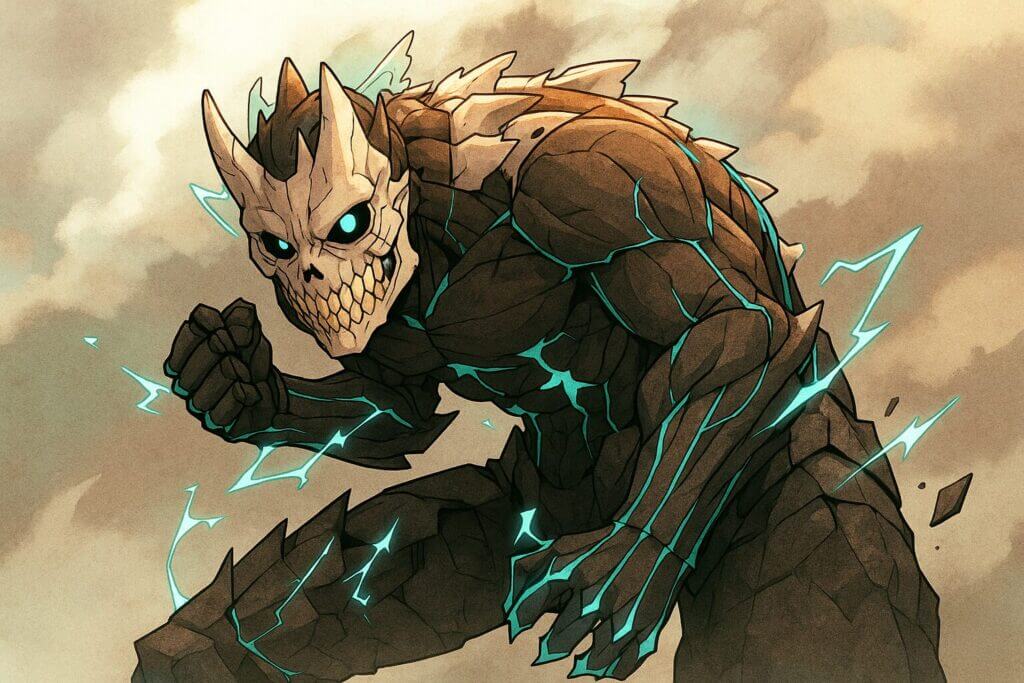
Meet the Monsters—and the Team
Throughout the series, Kafka faces off against increasingly intelligent and dangerous Kaiju—like Kaiju No. 9, who seems to be orchestrating attacks from the shadows. Along the way, he forms deep friendships, earns the trust of his team, and proves again and again that heart and determination matter just as much as strength.
More Than Just Monster Battles
At its core, Kaiju No. 8 is a story about resilience, teamwork, and redefining what it means to be a hero. With its balance of high-stakes action, heartfelt moments, and over-the-top comedy, it’s a series that’s just as fun to read as it is inspiring.
Main Characters in Kaiju No. 8
Here’s a quick introduction to some of the key characters you’ll meet in Kaiju No. 8:
Kafka Hibino
The main protagonist of the story, Kafka is a 32-year-old who works as a Kaiju cleaner, cleaning up after battles. After several failed attempts to join the Defense Corps, his life changes when he gains the ability to transform into Kaiju No. 8. Despite this, Kafka remains determined to protect humanity, even if he must hide his true identity.
Mina Ashiro
Kafka’s childhood friend and now the captain of the Third Division of the Defense Corps. She’s known for her incredible strength and skills in Kaiju battles, and Kafka looks up to her as he continues to pursue his dream of joining the Corps. Mina is dedicated to her mission of protecting Japan from the Kaiju threat.
Kikoru Shinomiya
A highly skilled and determined young recruit in the Defense Corps. She is the daughter of the powerful Isao Shinomiya, the Director General of the Defense Corps. Kikoru fights with a custom weapon made from Kaiju No. 3 and plays a crucial role in the story, developing a close bond with Kafka.
Reno Ichikawa
A promising young recruit and Kafka’s close friend. Reno is compatible with the Kaiju No. 6 ice weapon and uses it in battle. He deeply respects Kafka and fights alongside him while learning how to master his own powers.
Vice Captain Soshiro Hoshina
A top officer in the Defense Corps known for his expertise in close combat and swordsmanship. He now wears the Kaiju No. 10 battle suit, which not only enhances his abilities but also has a mind of its own, leading to some humorous moments in the story. Hoshina is highly skilled and plays a key role in protecting Japan from Kaiju.
Kaiju No. 9
The primary antagonist of the series, Kaiju No. 9 is a highly intelligent Kaiju who is able to evolve and adapt to the Defense Corps’ strategies. After absorbing the memories and power of Isao Shinomiya, Kaiju No. 9 becomes an even more dangerous threat.
These are just a few of the main characters in Kaiju No. 8. Each brings a unique personality and fighting style to the story, adding depth and excitement to the series.
Quick Story Arcs – Kaiju No. 8 Parents Guide
We get it—between school runs, snacks, and bedtime routines, reading every manga your kids are into isn’t always realistic. But if your child is obsessed with Kaiju No. 8 and you want to keep up, you’re in the right place! This parent-friendly guide gives you bite-sized summaries of each major story arc. That way, you can stay in the loop, understand the big plot twists, and talk Kaiju battles and character moments with your kids—without needing to binge every volume.
1 - Kafka’s Transformation (Volumes 1–2)
The Kaiju No. 8 plot kicks off by introducing Kafka Hibino, a 32-year-old man who once dreamed of joining the Defense Force to protect Japan from terrifying Kaiju attacks. Instead of fighting monsters, he’s stuck with a far less heroic job—scrubbing Kaiju guts as part of a post-battle cleanup crew. Kafka’s current reality is equal parts gross and humbling, and his dream of becoming a soldier seems long gone.
But that all changes with one very unexpected—and kind of gross—twist. After an encounter with a mysterious Kaiju parasite that literally flies into his mouth, Kafka gains the ability to transform into a Kaiju himself. Unlike typical monsters, though, he retains his human mind and emotions. Suddenly, the man who cleans up after Kaiju is now one of the most powerful beings around.
With his newfound powers, Kafka sees a chance to revive his dream and finally join the Defense Force. But there’s a catch—he has to pass the entry exam alongside much younger recruits and keep his Kaiju identity hidden from everyone, including his childhood friend Mina Ashiro, who’s now a high-ranking Defense Force captain.
This Kaiju No. 8 story arc sets the tone for the series with a fast-paced blend of humor, underdog grit, and high-stakes action. It’s a great intro for readers, especially kids who love stories about second chances and believing in yourself—even when the odds are stacked against you.
st-battle cleanup crew. Kafka’s current reality is equal parts gross and humbling, and his dream of becoming a soldier seems long gone.
But that all changes with one very unexpected—and kind of gross—twist. After an encounter with a mysterious Kaiju parasite that literally flies into his mouth, Kafka gains the ability to transform into a Kaiju himself. Unlike typical monsters, though, he retains his human mind and emotions. Suddenly, the man who cleans up after Kaiju is now one of the most powerful beings around.
Highlights from an Elementary School Reader
There are two moments that our daughter absolutely loved and couldn’t stop laughing at. The first comes early on when Kafka is still working as a cleaner. He’s assigned to clean the Kaiju’s intestine section, and with his over-the-top reaction, exclaiming “Nooo, not there!” as his coworker drags him into the gross task. Our daughter found this part hilarious and joked, “You know what’s in the intestines, right?” before laughing uncontrollably.
The second favorite part was when a Kaiju fly flies into Kafka’s body, transforming him into a Kaiju. What followed had her in stitches—the exaggerated emotions between Kafka and Reno Ichikawa as they freak out over Kafka’s transformation. The scene where Kafka, trying to escape, accidentally tears down an entire wall when attempting to open a window was another laugh-out-loud moment.
2 - Defense Force Entrance Exam (Volumes 2–3)
In this action-packed Kaiju No. 8 story arc, the stakes rise dramatically as Kafka and his fellow Defense Force recruits face their first major threat: a full-blown Kaiju invasion of Sagamihara City. The Defense Corps mobilizes for a large-scale battle, and for Kafka, this isn’t just about fighting monsters—it’s his chance to prove he truly belongs on the front lines.
As part of the neutralization squad, Kafka is thrown straight into the chaos alongside Reno Ichikawa. The Kaiju No. 8 plotintensifies with fast-paced combat scenes, destructive Kaiju attacks, and a growing sense of danger. Kafka has to fight while keeping his secret hidden, which becomes harder the more he sees people getting hurt. For kids reading along, this arc delivers big action with emotional weight, showing Kafka’s internal struggle to do what’s right—without being exposed as part Kaiju.
One of the most meaningful developments in this arc is Kafka’s evolving friendship with Reno. The two teammates face real danger together, building trust and a bond that carries through future arcs. Reno begins to suspect that Kafka might be hiding something, but he still stands by him when it counts—a great moment that highlights the series’ recurring theme of loyalty under pressure.
Parent tip: From a Kaiju No. 8 parents guide perspective, this arc contains more intense battle scenes than the first, but nothing overly graphic. The action is high energy and suspenseful, but still suitable for readers around age 10 and up, especially those who enjoy big battle moments and underdog heroes.
Highlights from an Elementary School Reader
One of the most exciting moments for our daughter was when Kafka comes to save the day just as his good friend Reno Ichikawa is on the verge of being defeated by Kaiju No. 9 (only powerful kaijus are given numbers). In a dramatic entrance, Kafka suddenly appears and unleashes his hidden Kaiju powers to fend off the enemy and protect Reno. This heroic rescue had our daughter cheering as Kafka used his abilities to turn the tide of the battle.
3 - Raid on Tachikawa Base Arc (Books 3-4)
This Kaiju No. 8 story arc marks a major turning point in the series, as the tone shifts from training and teamwork to all-out warfare. The Defense Corps’ Tachikawa Base is hit with a devastating surprise attack by a new, highly intelligent humanoid Kaiju—later revealed to be Kaiju No. 9—and a horde of reanimated Kaiju monsters. The base is thrown into chaos as the Defense Force scrambles to defend against this sudden and overwhelming threat.
Kafka, Reno Ichikawa, and Kikoru Shinomiya are thrust into the heart of the battle. As explosions rock the base and monsters close in, the team must step up in ways they never imagined. For kids following the Kaiju No. 8 plot, this arc introduces higher emotional stakes, sharper tactical challenges, and a fast-paced series of fights that showcase each character’s growth.
Kikoru, in particular, shines in this arc—proving herself to be one of the most skilled young recruits. She fearlessly takes on multiple Kaiju, showing bravery and sharp instincts beyond her years. Her strength and leadership offer younger readers a powerful female role model—something my daughter especially admired.
Meanwhile, Kafka faces a gut-wrenching dilemma. With lives on the line and the base nearing collapse, he must decide whether to unleash his Kaiju No. 8 powers—knowing full well that doing so could expose his secret and destroy his dream of serving alongside his team. His decision is a major moment in the story, showing kids the weight of responsibility and the courage it takes to protect others, even when it means personal risk.
Highlights from an Elementary School Reader
Two standout moments for our daughter were the intense battle between Vice Captain Hoshina and the new Kaiju boss. She loved how Hoshina moved “so fast, like a ninja,” showcasing his incredible speed and combat skills. Another favorite was when Shinomiya received her custom weapon, crafted from Kaiju No. 3’s body, making it far more powerful than standard weapons.
4 - Kaiju No. 8 Captured Arc (Books 4-5)
This pivotal Kaiju No. 8 story arc changes everything. After bravely using his powers to save the Defense Force during the Tachikawa Base raid, Kafka’s secret finally comes to light—he’s identified as the mysterious humanoid Kaiju the Corps has been tracking. His heroic actions may have saved lives, but now he’s officially a suspect, not a soldier.
Kafka is captured and placed under tight surveillance. From a Kaiju No. 8 plot standpoint, this arc focuses less on external battles and more on internal conflict—Kafka’s own emotional struggle and the growing uncertainty within the Defense Force. He’s subjected to intense testing to determine how much of his humanity remains and whether he poses a threat.
Vice Captain Hoshina becomes a central figure here. He’s torn between his duty to protect the Corps and his respect for Kafka, whose bravery during the raid is undeniable. The tension between protocol and personal conviction plays out in powerful scenes, showing kids how complicated leadership—and friendship—can be when trust is tested.
Meanwhile, Kafka’s relationships with Reno and Kikoru face new pressure. They must decide where they stand now that Kafka’s true identity is exposed. Will they stand by him or fear what he might become?
This arc raises thoughtful questions that resonate with older kids and tweens: What defines a monster? Can you still be a hero if the world sees you as a threat?
Parent tip: While not as action-heavy, this Kaiju No. 8 parents guide flag notes that this arc adds emotional depth. It’s less about fighting and more about trust, identity, and second chances—important topics that spark great family discussions.
Highlights from an Elementary School Reader
One of the most gripping moments for our daughter was the climactic fight between Kafka and Kikoru’s dad, the Director General of the Defense Force and one of the most powerful characters. At the end of the battle, Kafka loses control of the Kaiju power inside him and nearly kills Kikoru’s dad. But at the very last second, because of his deep friendship with Kikoru and his desire not to hurt her or her father, along with words in his head “I will be waiting” from Mina, Kafka punches himself instead of delivering the final blow. This powerful moment had a big impact on our daughter, showing Kafka’s inner strength and care for his friends.
5 - Kaiju Weapon Arc (Books 5-7)
As the Kaiju No. 8 plot escalates, this story arc introduces a major shift in strategy: the Defense Corps begins developing powerful weapons from the remains of defeated Kaiju, called Numbered Weapons. These high-risk, high-reward tools are designed to give humanity a fighting chance against increasingly intelligent and deadly Kaiju.
One of the arc’s standout moments comes when Kikoru Shinomiya is chosen to wield a custom weapon made from the body of Kaiju No. 3. This weapon dramatically boosts her strength and marks her as one of the most promising young soldiers in the Corps. It’s a big moment, especially for younger readers who admire strong female characters—my daughter was so excited to see Kikoru power up and hold her own alongside elite fighters.
New Units, New Challenges
With the Kaiju threat expanding across Japan, the Defense Force spreads out its strongest fighters. Kafka and Kikoru are both reassigned to Division 1, the most elite unit in the nation, led by the eccentric but incredibly powerful Captain Gen Narumi. His character adds a humorous twist—he’s messy, game-obsessed, and not exactly what you’d expect from the top captain—but he’s also a strategic genius in combat.
Under Narumi’s leadership, Kafka and Kikoru face tougher training, more dangerous enemies, and higher expectations. This Kaiju No. 8 story arc raises the bar for action and character development, showing kids how teamwork and grit are essential even when things get chaotic.
Kaiju No. 9 Strikes Again
But the arc takes a darker, more emotional turn when Kaiju No. 9 returns—this time with a terrifying goal: to steal the power of Kaiju No. 2, which currently resides in Isao Shinomiya, the Director General of the Defense Corps and Kikoru’s father. What follows is one of the most intense battles in the series.
Despite his formidable power, Isao is ultimately defeated by Kaiju No. 9, who absorbs both his body and the power of Kaiju No. 2. The loss is a crushing blow to the Corps and a deeply personal tragedy for Kikoru. The emotional weight of this scene adds serious depth to the Kaiju No. 8 plot, showing readers that the battle against the Kaiju comes with real sacrifices.
Parent tip: From a Kaiju No. 8 parents guide standpoint, this arc is heavier than the earlier ones. There’s intense action and emotional loss, especially involving Kikoru’s relationship with her father. Still, it’s handled thoughtfully and offers great themes about courage, grief, and resilience—ideal discussion points for young readers.
Highlights from an Elementary School Reader
Our daughter found Narumi’s introduction absolutely hilarious. When Kikoru and the vice captain enter Narumi’s room, they find it a total mess, with Narumi lying on the floor under a blanket playing video games after staying up all night. She thought it was funny that someone else’s room could be even messier than hers! The scene becomes even funnier when the vice captain, acting like his mom, tells Narumi to clean up or he’ll throw everything away.
6 - The Compatible User Arc (Books 7-8)
After the heartbreaking loss of Director General Isao Shinomiya, absorbed by Kaiju No. 9 along with the secrets of the Defense Corps, the organization faces a full-scale crisis. With Kaiju No. 9 now possessing classified intel and enhanced powers, the Kaiju No. 8 plot pivots toward innovation and survival. The Defense Corps realizes that its future lies in its younger recruits—and that unexpected heroes may be the key to defeating the Kaiju once and for all.
Weaponized Kaiju and the Rise of Compatible Users
To turn the tide, the Corps ramps up its Kaiju weapon program, developing high-level gear from the remains of powerful monsters. But these weapons—known as Numbered Suits—can only be wielded by “compatible users,” people whose physical and mental strength can match the immense power within.
Reno Ichikawa takes center stage in this Kaiju No. 8 story arc when he’s revealed to be compatible with the suit made from Kaiju No. 6, a deadly ice-type Kaiju that once defeated Kikoru’s mother. With this suit, Reno gains powerful ice-based abilities, giving him a much-needed edge as Kaiju attacks grow more frequent and ferocious.
Shinomiya, absorbed by Kaiju No. 9 along with the secrets of the Defense Corps, the organization faces a full-scale crisis. With Kaiju No. 9 now possessing classified intel and enhanced powers, the Kaiju No. 8 plot pivots toward innovation and survival. The Defense Corps realizes that its future lies in its younger recruits—and that unexpected heroes may be the key to defeating the Kaiju once and for all.
Kikoru’s Emotional Upgrade
Kikoru Shinomiya is also revealed to be a compatible user—of Kaiju No. 4, the suit her late mother, Hikari Shinomiya, once wore before she died in battle. This emotional connection gives her strength and adds depth to her ongoing journey. One of the most touching moments in this arc comes when Kikoru quietly says, “Mommy, give me strength,” before heading into battle. It’s a powerful message for young readers about legacy, courage, and honoring the past.
Hoshina and Kaiju No. 10: Frenemies in Combat
Meanwhile, one of the most surprising—and oddly hilarious—developments in the Kaiju No. 8 plot is the return of Kaiju No. 10, now reduced to just a severed, talking head. Rather than disappearing from the story, No. 10 actively chooses to fight alongside the Defense Force. He requests to be made into a battle suit for Vice Captain Hoshina, the man who defeated him.
Why? Because Kaiju No. 10 loves a good fight—and he sees Hoshina as the ultimate combat partner. Their dynamic becomes one of the most entertaining parts of this arc: part buddy cop, part battle-hungry duo. It’s a standout moment that adds humor, action, and unexpected teamwork to the story.
Parent Tip
This arc focuses heavily on new powers and emotional development, with less graphic violence and more emphasis on teamwork, grief, and growth. In this Kaiju No. 8 parents guide recommends the arc as a meaningful turning point—especially for kids who enjoy character evolution and cool, video game-like upgrades.
Highlights from an Elementary School Reader
Our daughter loved seeing Reno use his ice powers against a Kaiju monster. She especially found it heartwarming when Iharu gave Reno a piggyback ride after the battle. Reno had overextended himself trying to defeat the Kaiju alone and almost lost control to the Kaiju’s power. But in a touching moment, Iharu, as a good friend and teammate, came to the rescue, pulling Reno out of his despair and helping him regain control. This moment really stood out as a great example of friendship and teamwork.
7 - Cataclysms Arc (Books 8-9)
In this intense Kaiju No. 8 story arc, Japan is hit with a wave of coordinated, large-scale Kaiju attacks—known as the Cataclysms. No longer isolated incidents, these assaults occur across multiple cities and regions, leaving the Defense Corps overwhelmed. The Kaiju No. 8 plot takes a darker, more urgent tone here, as the sheer volume and strength of the Kaiju push humanity to the edge of collapse.
At the center of this chaos is Kaiju No. 9, now armed with the devastating power of Kaiju No. 2 and the insider knowledge stolen from Isao Shinomiya. His attacks are strategic, brutal, and relentless, forcing the Defense Force to deploy all of its newly developed Kaiju weapons and rely heavily on their compatible users.
All Hands on Deck
Kafka, still struggling to fully master his powers as Kaiju No. 8, is thrust into his most dangerous battles yet. This arc is a turning point in the Kaiju No. 8 plot as Kafka moves beyond trying to prove himself—he must now stand shoulder-to-shoulder with the strongest fighters in the Corps to protect innocent lives on a national scale.
Reno Ichikawa, with his ice-based powers from Kaiju No. 6, and Kikoru Shinomiya, armed with her mother’s Kaiju No. 4 suit, play increasingly central roles on the battlefield. Their teamwork, growth, and determination show young readers how perseverance and support can carry you through even the toughest fights.
Vice Captain Hoshina, now partnered with the battle-hungry Kaiju No. 10 suit, becomes a frontline powerhouse. The unique bond between man and monster provides both comic relief and intense combat effectiveness in this arc.
Highlights from an Elementary School Reader
One of her favorite parts was the playful interactions between Kafka and Kikoru, whose teasing and bickering show their close friendship. Ever since Kafka’s capture in Arc 4, about two months have passed, and he hasn’t spoken to his old teammates except for Kikoru.
In this arc, Kikoru returns Kafka’s phone and tells him he can use it again, encouraging him to reach out to his friends. She also loved how Kafka nervously turned on his phone, expecting his teammates to be angry for hiding his Kaiju powers, but instead found heartwarming messages asking if he was okay and telling him to “come back safe.” Kafka’s funny, sad, teary face during this moment was a highlight. She also found it hilarious when Reno called, and Kafka freaked out, dropped his phone, and accidentally hung up. When Kafka finally answered the next call thinking it was Iharu, Reno’s reaction—saying, “Why did you answer when you thought it was Iharu?”—had her laughing out loud at Kafka’s silly and over-exaggerated faces during the exchange between these two good friends.
8 - The Second Wave Arc (Books 10-11)
In this powerful Kaiju No. 8 story arc, Kaiju No. 9 launches a brutal counteroffensive—sending out five new numbered Kaiju, each uniquely designed to exploit the personal weaknesses of Japan’s top Defense Force fighters. These engineered monsters aren’t just strong—they’re calculated, personal, and meant to push each hero to their psychological and physical breaking points.
Kikoru vs. Kaiju No. 15 – A Battle of the Mind
Kaiju No. 15 uses psychological attacks to exploit Kikoru Shinomiya’s mental vulnerabilities. As
Kaiju No. 15 is created as a near-perfect mirror of Kikoru Shinomiya, drawing on memories absorbed from her father to target her emotional vulnerabilities. With the ability to unleash powerful mental attacks, No. 15 sends Kikoru into a psychological spiral, confronting her deepest fear: that she’ll never live up to her parents’ expectations.
In one of the most emotional scenes of the Kaiju No. 8 plot, Kikoru sees a vision of her late mother, Hikari Shinomiya—the original wielder of the Kaiju No. 4 weapon. Rather than weakening her, this moment fuels Kikoru’s resolve. She taps into the legacy of her family, learning instinctive battle techniques passed down through memory and surpassing even her mother’s skills.
But when Kaiju No. 15 lands a final mental blow, Kikoru nearly loses herself—until Kafka’s voice crackles through the radio: “I believe in you.” The words she once used to encourage Kafka now return to lift her. This beautiful full-circle moment reminds her that she no longer fights for approval—but for the people by her side. With newfound strength, she defeats Kaiju No. 15, breaking free from the emotional chains of the past.
a mirror image of Kikoru and armed with the memories of her father, absorbed by Kaiju No. 9, Kaiju No. 15 turns the battle into a deeply personal and emotional struggle for Kikoru. During the fight, she sees the ghost of her mother, Hikari Shinomiya, who once wielded the Kaiju No. 4 weapon—the very weapon Kikoru now uses. This connection pushes Kikoru to surpass her limits, allowing her to essentially learn new battle techniques from her mom. Although she ultimately surpasses her mother’s ability, she’s hit by a final mental attack that almost consumes her.
In a pivotal moment, Kikoru hears Kafka’s voice over the radio saying, “I believe in you”—words she had often told him in the past. This reminds her that she now has friends and people she wants to be recognized by, beyond just her parents. This realization allows Kikoru to outgrow the emotional burden of seeking her parents’ approval, bringing her out of the enemy’s grip and giving her the strength to finally win the battle.
Narumi vs. Kaiju No. 11 – Learning to Adapt
Elsewhere, Captain Gen Narumi faces off against Kaiju No. 11, a water-type creature designed to nullify Narumi’s own weapon: the Kaiju No. 1 brain interface, which allows him to read opponents’ movements via electrical signals. But Kaiju No. 11 doesn’t use those signals—making Narumi’s power completely useless.
This unexpected twist forces Narumi, typically calm and confident, to fight with raw instinct and inventiveness. It’s a critical moment in the Kaiju No. 8 plot that highlights the importance of adaptability and strategy over raw power.
Hoshina vs. Kaiju No. 12 – Swordplay and Self-Discovery
While Kikoru battles her past, Vice Captain Hoshina faces Kaiju No. 12, a monster engineered to counter his expert sword skills. Hoshina now fights while wearing the Kaiju No. 10 suit, which still has a personality of its own—often leading to hilarious mid-battle banter as the two argue like an old married couple while dodging deadly attacks.
As the battle wears on and fatigue sets in, Hoshina begins to falter. But then, Kaiju No. 10 delivers an unexpected pep talk: “You don’t want to quit, right?” This line triggers a flashback to Hoshina’s childhood, when he constantly sparred with his older brother. It’s in this moment that Hoshina reconnects with the reason he fights—not for rank or duty, but for joy. “Swingin’ the sword is fun,” he remembers, smiling mid-duel.
Reignited by his love of swordsmanship, Hoshina presses forward with razor-sharp focus, ultimately achieving 100% compatibility with the Kaiju No. 10 suit and defeating his perfectly matched foe.
Highlights from an Elementary School Reader
Our daughter found the battle between Kikoru and Kaiju No. 15 a bit more intense than usual, especially due to the mind attacks where Kikoru relived memories from her childhood, seeking approval and praise from her parents. However, she seemed to skip over the deeper conversations between Kikoru and Kaiju No. 15, instead focusing on how cute she thought Kikoru looked as a little girl in the flashbacks.
9 - The Last Wave – The Final Stand Begins
In this climactic Kaiju No. 8 story arc, the pieces finally fall into place for a massive, all-out war between humanity and the Kaiju. After countless battles, personal sacrifices, and character growth, Kafka Hibino and the Defense Force now face their greatest test yet. Kaiju No. 9, now more powerful than ever, prepares for his ultimate plan—a full-scale final assault on Japan that threatens to wipe out everything the Defense Corps has fought to protect.
Kafka’s Identity on the Line
For Kafka, the line between human and Kaiju has never been thinner. While he’s managed to retain control of his mind and use his Kaiju No. 8 form for good, this arc explores the terrifying possibility of losing himself to the power inside. He’s no longer just a secret weapon—he’s become a symbol of hope, and possibly, humanity’s last line of defense. But the more Kafka pushes his limits, the more everyone begins to wonder: can he truly hold onto his humanity?
This internal struggle becomes a major focal point of the Kaiju No. 8 plot as Kafka must decide how far he’s willing to go to stop Kaiju No. 9—even if it means risking everything, including himself.
The Defense Force Unites
Meanwhile, the Defense Corps rallies every division and every remaining weapon for a final push. Reno, Kikoru, and Hoshina—now battle-hardened veterans—step into leadership roles, leading coordinated efforts to hold off the Kaiju waves. Their powers are at their peak, and so is their determination.
This arc pulls together threads from across the entire series: Kikoru’s evolution from prodigy to warrior, Reno’s rise from rookie to ice-wielding powerhouse, and Hoshina’s deepened bond with Kaiju No. 10. It’s the culmination of everything they’ve trained for—and it all comes down to this moment.
Kaiju No. 9’s Endgame
Kaiju No. 9, now almost godlike in strength and intelligence, begins executing a final plan that ties back to secrets buried deep within the origins of the Kaiju. The Kaiju No. 8 story arc moves toward deeper lore, suggesting that the battle isn’t just about strength—it’s about understanding the Kaiju themselves.
While much of this arc is still unfolding in the most recent chapters, the tension, world-building, and emotional stakes are at their highest.
Parent Tip
From a Kaiju No. 8 parents guide view, this arc is heavier in tone, more emotional, and packed with climactic action. The pacing is faster, the battles are larger, and Kafka’s identity struggle may spark deeper conversations with your child about self-control, sacrifice, and what it means to be human.
Is There a Kaiju No. 8 Anime?
Yes—there is a Kaiju No. 8 anime, and it’s fantastic! The series premiered on April 13, 2024, and is currently streaming on Crunchyroll. If your kids are more into watching than reading, this is a great entry point into the world of Kaiju No. 8.
We watched it as a family and were blown away by the animation. It’s visually stunning, with crisp art, fluid motion, and dynamic angles that bring every Kaiju battle to life. The pacing is fast and exciting, keeping even younger viewers engaged from start to finish. Our elementary-aged daughter especially loved the goofy and exaggerated comedy scenes—she was laughing out loud more than once!
And let’s talk about the fight scenes: they’re epic. The anime takes the thrilling action of the manga and levels it up with sound, color, and energy that make each moment even more intense and dramatic.
The first season includes 12 episodes and adapts the first four story arcs—from Kafka’s transformation to the raid on Tachikawa Base. If your kids (or you!) are eager to see what happens next, the Kaiju No. 8 manga picks up right where the anime leaves off.
Needless to say, we’re counting down the days until Season 2 drops!
Where Can You Read Kaiju No. 8 Online?
Yes, you can read Kaiju No. 8 online—and it’s super easy! If you’re okay with your kids getting some extra screen time (especially for reading), we highly recommend the Shonen Jump app by VIZ Media. We personally subscribe and think it’s an amazing deal—just around $2 a month (at the time of writing)—for unlimited access to a huge library of manga, including Kaiju No. 8.
It’s a great digital option for on-the-go reading or if you’re not ready to invest in the full book set yet.
That said, if you’re like us and want to limit screen time, the physical books are also worth it. We love collecting them—our daughter takes pride in building her own manga shelf! Having the paper version also makes it easier to reread favorite scenes, flip through artwork, and enjoy stories without a device in hand.
So whether you go digital through the app or old-school with books, Kaiju No. 8 is accessible, affordable, and an exciting way to keep kids reading.
Similar Manga to Kaiju No. 8 – What to Read Next
If your child is hooked on Kaiju No. 8 and already asking what to read next, you’re not alone! The good news is there are plenty of other manga series that combine exciting action, humor, and heartfelt character development. Here are some Kaiju No. 8-approved picks your kids might love:
My Hero Academia
If they enjoy seeing underdogs rise to greatness, this is a perfect next step. Like Kafka, the main character, Deku, starts off powerless but dreams of becoming a hero in a world where most people have superpowers. There’s plenty of action, school rivalries, and emotional growth—plus, lots of cool powers to keep things exciting.
Parent tip: Some scenes can be intense, but it’s generally a good fit for ages 10+.
Dragon Ball / Dragon Ball Super
A true classic in the world of manga and anime, Dragon Ball has been entertaining generations of fans since the 1980s. If your child loved the explosive fights and goofy humor in Kaiju No. 8, this series is a natural next step.
The story follows Goku, a cheerful martial artist with a mysterious past, as he trains, explores new worlds, and faces off against powerful foes. The original Dragon Ball starts with a light, comedic tone and gradually builds into epic tournament battles and high-stakes adventures. Dragon Ball Super picks up the story with even bigger battles and modern pacing, making it a great way for new readers to jump in.
Parent tip: While some episodes and scenes feature fantasy violence and suggestive humor, it’s generally suitable for ages 9–12+, especially for kids who are already into action manga. It’s an iconic series that offers a fun blend of laughs, training montages, and heroic moments—plus, it’s a great way for parents to bond with their kids over something they may have grown up with too!
🏴☠️ One Piece
This legendary series follows Monkey D. Luffy and his pirate crew as they sail the Grand Line in search of the ultimate treasure, the One Piece. Much like Kaiju No. 8, One Piece combines over-the-top action with big laughs, heartfelt friendships, and a main character who never gives up on his dream—even when the odds are against him.
If your child connected with Kafka’s goofy personality and determination, they’ll likely love Luffy’s fearless (and often hilarious) approach to challenges. And with strong female characters like Nami and Robin, plus endless creative world-building, there’s something for everyone.
Parent tip: One Piece is fairly kid-friendly but has some occasional cartoonish violence, mild language, and complex arcs. Before you set sail with Luffy and the Straw Hat crew, be sure to check out our full parent review of One Piece—we break down what to expect by age, share story highlights, and offer tips for helping younger kids follow the long (but rewarding!) journey.
SPY x FAMILY
While there are no Kaiju here, SPY x FAMILY is a great pick for kids who love secret identities, fast-paced action, and a quirky mix of characters. The story follows Loid, a spy who builds a fake family for a mission—unaware that his “wife” is an assassin and his “daughter” is a mind-reading telepath.
Like Kaiju No. 8, it’s full of heart, humor, and hidden identities. Anya’s funny expressions and the family’s wild misunderstandings make this series a hit with tweens.
Parent tip: Recommended for ages 10+. It includes some stylized action and light innuendo, but nothing too intense. A great next read for kids who enjoy humor with a side of espionage.
Final Thoughts: Why Kaiju No. 8 Is Worth Reading with Your Kids
Whether your child is drawn to the explosive monster battles, the goofy humor, or the inspiring journey of an underdog hero, Kaiju No. 8 offers more than just action—it delivers heart, growth, and lasting messages about friendship, courage, and second chances.
As the story progresses through each arc, readers not only see Kafka Hibino transform physically into a Kaiju, but also emotionally as he finds his place among powerful allies and earns the trust of a team he once thought he could never join. Alongside him, characters like Kikoru, Reno, and Hoshina each fight their own battles—both external and internal—making this series rich with character development and emotional depth.
From a parent’s perspective, Kaiju No. 8 strikes a rare balance. It’s fast-paced and fun enough to keep kids flipping pages, but also layered with themes that invite meaningful conversations—about failure, perseverance, identity, and what it really means to be strong. While the Kaiju No. 8 age rating (generally 10+) feels right due to fantasy violence and some emotional complexity, younger readers with experience in similar manga may also enjoy it with a bit of guidance.
We hope this Kaiju No. 8 parents guide and story arc breakdown helps you stay connected to your child’s latest reading adventure—even if you haven’t had time to read every chapter yourself. So whether you’re joining in for a few laughs or diving into a deep discussion about Kikoru’s emotional growth, this manga is a rewarding ride for kids and parents alike.

